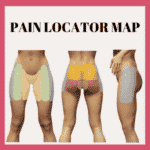
Nordic Pole Walking is a popular recreational activity using light weight poles when walking for many benefits including pain relief and health gains. Developed in Scandinavian countries, as the name suggests, the benefits of Nordic pole walking have been recognised globally and are used by many for a multitude of reasons.
In this blog on the benefits of Nordic pole walking, we'll be covering the following main topics:
For each topic, our aim will be to clarify how Nordic pole walking can assist and specific conditions for which they may be valuable. Walking with Nordic poles restores many people's ability to be physically active, due to reductions in pain and improvements in balance and confidence.
Increased physical activity can assist with maintaining or increasing muscle strength, joint mobility, cardiovascular health and fitness, a healthy weight range, confidence, improved mental health and quality-of-life.
So many benefits for getting physically active! Nordic poles might be your opportunity to enjoy some of the many benefits of physical activity.

Would you like to purchase your own Walking Poles?
Want to explore the range of walking poles we recommend?
Click the link below to find out more!
Research has shown that Nordic pole walking can help reduce back pain.1 Let's look at how walking poles might help and particular back pain conditions that might benefit.

Back conditions that may be helped with Nordic pole walking include:
When first starting to walk with poles, start with a similar distance you can manage without poles, and then gradually increase your distance depending on your pain. It takes time to build your strength and endurance, so allow time for your body to adapt. Remember, if you haven't been able to walk for some time, you will no longer be walk-fit. Build slowly over 2-3 months, adjusting distance and terrain depending on your response.
We have seen in the section above how walking poles can help provide pain relief in those with chronic back pain. Hip and pelvic pain may be coming from your back, in which case Nordic pole walking may help reduce pain due to the beneficial effects on the back. You can read more about back pain felt in the hips and pelvis HERE.
Nordic pole walking has also been shown to help reduce hip pain.1 Let's look at how walking poles might help and particular hip pain conditions that might benefit.

Due to all the reasons we discussed above, Nordic pole walking may assist with many different hip conditions.
Hip and pelvic conditions that may be helped with Nordic pole walking include:

Similarly to back and hip pain, walking poles can help provide knee pain relief.1
This is likely to be in ways that we have discussed throughout the sections above, but we will give a brief summary here.
Once again, pushing down on the poles using the upper body means the arms support part of the body weight, reducing weightbearing loads crossing the knee. This is a likely way that Nordic walking poles can help relieve pain.
Improved balance provided by the poles helps to provide support to the lower limbs. They are particularly useful on more unstable surfaces, where a loss of balance or footing may result in a sudden jerking across the joints and pain irritation.
As we mentioned above, people with hip pain, reduced range of motion, or weakness, may start moving in ways that increases load elsewhere, such as at the lower back and knee. Walking poles can assist with improving biomechanics (movement patterns) as you work on improving strength and range of motion.
Being able to walk with less knee pain, means you can walk more1 helping to maintain good knee function, but also the general health benefits including weight control. Carrying excess weight can affect those with knee osteoarthritis.
Keeping weight within a healthy range is one of the key recommendations for managing knee osteoarthritis. That can be difficult when you can't be active due to your pain. Nordic walking poles can assist you to maintain higher levels of activity. Weight control will always be most effective in conjunction with a balanced diet.

Be aware that knee pain can be referred from the hip. If no-one has been able to find an explanation for your knee pain, then get your hip checked by a healthcare provider who knows hips, such as a Hip Pain Professional.
Knee pain reduced by Nordic walking poles may be related to reduced load at the hip or the lower back, both potential sources of knee pain.
The benefits of pole walking extend beyond just pain relief. Extensive benefits to general health and fitness have been well demonstrated. So, what are these other general health benefits of pole walking?
Nordic pole walking may assist in maintaining or improving muscle strength and health, particularly in the upper body and abdominal muscles. Being able to walk further and more often may also indirectly help to strengthen your legs.
One key general health benefit of pole walking is weight management. Pole walking can be an excellent way to counteract obesity or trim those few extra pounds or kilograms.8 Nordic pole walking has been shown to use up to 22% more calories than normal brisk walking!9
There is a whole heap of other general health benefits of Nordic pole walking. We'll summarise them here.
General health benefits of pole walking may include:

As more and more studies are being completed, we are able to see the wider benefits of Nordic pole walking across many different groups, struggling with many different conditions that directly or indirectly affect mobility.
In people with Parkinson's Disease, beneficial effects of Nordic pole walking have been demonstrated. With regular pole walking, patients have been shown to have improved movement skills, improved functional mobility, and improved ability to walk at faster speeds and longer distances.
These improvements are likely to have contributed to a reduced rate of falls, improvement in functional independence and an improved quality of life that have been reported in people with Parkinson's disease after a Nordic pole walking program.11,12
Regular physical activity positively affects exercise tolerance and quality-of-life in people living with cancer. After mastectomy surgery for breast cancer, Nordic walking additionally improves shoulder mobility and reduces sensitivity to pain in the upper body. This has been shown to occur without worsening lymphedema.12
A Nordic walking pole program in those with chronic obstructive pulmonary disease (COPD) demonstrated improvements in perceived breathlessness during physical exertion. Further, Nordic walking improved anxiety and depression, and improved quality-of life for people with COPD.12
Benefits have also been shown in those with obesity, coronary artery disease (heart disease), peripheral artery disease (vascular disease) and claudication (pain related to lack of blood supply).12

There are many reasons to consider trying Nordic pole walking. There is an initial learning phase to coordinate walking with poles, but with practice, most people are able to adapt and get used to this new way of walking, while gaining all the benefits listed above.
We hope that this blog will give you some ideas as to the benefits of pole walking, and if you suffer from pain, why Nordic poles for pain relief can be valuable.
Please note, if you have pain or a health condition, we always recommend you seek the advice of a Health Professional before starting any new exercise routine. Check with your Doctor - general medical practitioner or medical specialist, or physical therapist about using Nordic poles to assist walking.

Visit our Pain Locator Map to learn more about pain in different regions around the hip and pelvis.
Top Tips for Hip Pain Relief Sitting, when Socialising or Travelling
Top Tips on Hip Pain Relief Sleeping
3 Simple Strategies to Reduce Hip Pain with Walking and Running
This blog was written by Dr. Alison Grimaldi, with contribution from one of our Hip Pain Professionals, Kirsty McNab, experienced physiotherapist.
Dr. Alison Grimaldi is a globally recognised expert physiotherapist, researcher, and educator, who has over 30 years professional clinical experience helping patients recover from a wide range of hip and pelvic conditions.

Dr. Alison Grimaldi BPhty, MPhty(Sports), PhD, FACP
Dr Grimaldi has completed Bachelor of Physiotherapy, Master of Physiotherapy and Doctor of Philosophy (Physiotherapy) degrees. She is a fellow of the Australian College of Physiotherapists, Practice Principal of PhysioTec Physiotherapy, an Australian Sports Physiotherapist , an Adjunct Senior Research Fellow at the University of Queensland, as well as an author and global educator. Her passion is helping people with hip pain, and educating other health professionals around how to help more people with hip pain.
